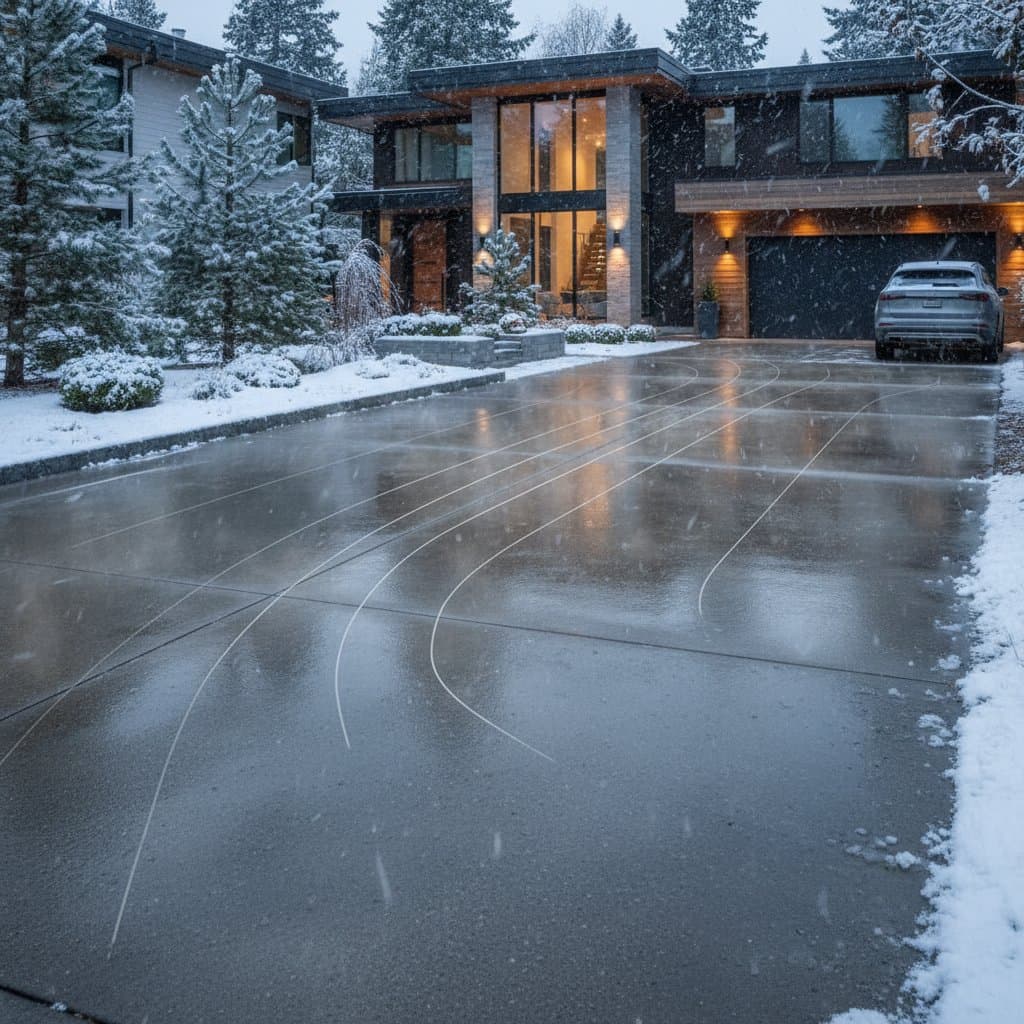Understanding Heated Driveways
Heated driveways utilize radiant energy to melt snow and ice without manual intervention. Rather than applying salt or operating snow removal equipment, these systems warm the pavement surface from below, preventing snow from adhering. This approach maintains a consistent temperature that keeps pathways clear effortlessly. Such systems integrate seamlessly into new concrete installations or retrofits beneath existing surfaces, based on site configuration and accessibility.
Two primary types of heated driveway systems are available. Hydronic systems circulate heated fluid through durable tubing, whereas electric systems employ embedded heating cables. Hydronic options prove ideal for expansive or high-traffic driveways, offering superior long-term energy efficiency. Electric variants enable quicker installation and suit compact spaces or targeted areas like inclines and tire paths.
Selecting the appropriate system demands thoughtful planning. Factors such as water drainage, pavement thickness, local climate, and automation controls influence both effectiveness and expenses. When implemented correctly, heated driveways provide dependable performance and enduring benefits.
The Return on Investment from Heated Driveways
Heated driveways yield a strong return on investment through time efficiencies, decreased upkeep, and prolonged pavement longevity. Automated snow clearance during storms eliminates hours of labor, avoids equipment wear, and reduces material costs. Across multiple seasons, these advantages accumulate into significant financial gains.
Minimizing Pavement Damage
Freeze-thaw cycles lead to cracks and surface deterioration in concrete. Radiant heating maintains the slab above freezing temperatures, stopping water from expanding within pores. As a result, the driveway endures longer, with repair schedules extended and replacement needs deferred.
Cutting Chemical Applications
Traditional deicers corrode concrete and damage surrounding plants. A heated surface removes the necessity for most chemical interventions, safeguarding landscapes and preventing environmental pollution from runoff.
Enhancing Property Appeal
The presence of a heated driveway conveys contemporary convenience and reliability. It improves visual attractiveness and usability, which potential buyers value highly in regions prone to heavy snowfall.
Boosting Safety Standards
Clear, ice-free surfaces lower the risk of falls for household members and guests. Reduced incidents translate to fewer medical concerns and legal exposures, particularly in homes with regular visitors or short-term rentals.
Steps to Plan Your Heated Driveway Installation
Determine early if the project requires professional expertise or allows for partial self-management. Integrating heating elements into concrete involves accurate placement and familiarity with electrical or plumbing systems. Connections to power sources or heating units necessitate certified specialists to ensure compliance and safety.
Site Evaluation Essentials
Inspect the terrain for inclines, water flow directions, and current surface integrity. Poor drainage hinders system efficacy, while insufficient under-slab insulation leads to energy loss. Consider integration with adjacent areas like sidewalks or garage approaches, adhering to local regulations on zoning and water management.
Material Selection Guide
-
Hydronic Tubing: Resilient polymer lines positioned over insulation and within concrete.
Advantages: Optimal for broad coverage, adaptable to various energy inputs.
Drawbacks: Elevated initial investment, intricate setup process. -
Electric Heating Cables or Mats: Straightforward wiring grids placed in the foundational layer.
Advantages: Swift deployment, low ongoing care.
Drawbacks: Greater electricity consumption per area, suited to limited zones. -
Automation Controls: Sensors for temperature and precipitation that adjust heating dynamically.
Advantages: Optimizes resource use.
Drawbacks: Demands precise tuning by experts.
Essential Tools and Preparation
Assemble tools such as a concrete cutting saw, rebar shaping device, finishing trowels, and a precision level. For hydronic installations, include a pressure testing gauge and distribution manifold tools. Secure a vibrating plate compactor to firm the base layer. Verify component interoperability prior to concrete placement to avoid complications.
Strategies for Maximizing System Longevity
Allocate ten percent extra length for tubing or cables to accommodate design adjustments during layout. Install insulation beneath the slab to channel heat effectively upward, enhancing overall performance. Program controls to initiate heating in anticipation of precipitation, achieving optimal melting speeds.
Sustaining Performance Year After Year
Conduct annual system reviews to preserve functionality. Verify sensor accuracy ahead of the cold season, remove obstructions from water channels, and apply protective sealants to the concrete as required. Address any irregular heating patterns promptly by consulting specialists to inspect electrical integrity or circulation issues. These practices ensure the driveway remains a reliable asset, delivering safety and convenience through countless winters while continuing to offset costs effectively.
